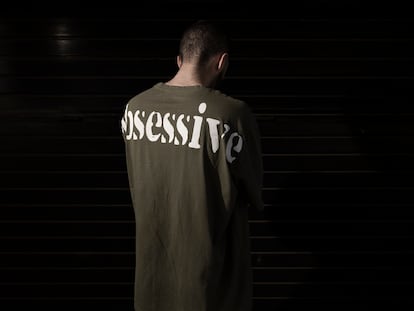‘This is not your normal masturbation’: Artificial intelligence comes to male sex toys
Faced with taboos around sexuality and getting off, sexologists suggest taking advantage of technological advancements to get to know ourselves better and amp up our pleasure

“Devices like this are like walking down routes you usually drive. You discover new things along the way that you had never seen before. Even though it gets you to the same place, orgasm, even though it works off of each person’s rhythms and mood, even though that’s all the same, the beauty of the device is that you notice new and wonderful things.” The speaker of these words is Jaime Martínez, a man from Madrid who is trying out a male sex toy for the first time. He took the latest advancement in sexual satisfaction out for a drive: an artificial intelligence-equipped masturbator. Gadgets like the Lelo F1S V3, to name one example, incorporate AI and augmented reality into their stroke. They’re not very different, in principle, from other, more established mechanisms: the penis is inserted into a silicone-lined cylindrical device, grooved for one’s pleasure and to simulate penetration. It is accompanied (and this is where the novelty comes in) by different vibrations. The F1S V3 can be used in analogue mode — unconnected to a smart phone — and has eight settings with eight different speeds. Call it a Formula 1 car in the race to orgasm. “You’re still jacking off, but this is no normal jack-off,” says Martínez.
“In general, I liked it. It touches erogenous zones that are complicated to stimulate using traditional methods,” says Alberto, a 24-year-old who has also tried the device. Men can try out different speeds and modes and save their favorites to their telephone. “Afterwards, you feel spent. It bears a certain resemblance to when you finish a very pleasurable sexual experience,” he adds.
Before we analyze these new tools in detail, where does our impulse to reach down to our private parts come from? René Descartes was among the first contemporary philosophers to see nature as nothing more than matter subject to the will of humans, imparting to us full control over the external world for our own benefit. Purchasing toys in a sex shop most certainly fits into Descartes’ view of humanity. Experimenting with personal satisfaction and our own genitals is ancestral: primates have been masturbating for at least 40 million years and the first record of sex toys dates back to 28,000 years ago, during prehistoric times.
Even before the inventions of PVC, lubricant and other substances that today give shape to sex toys, humans were already obsessed with using nature for our own pleasure. The first archaic sex toys — besides naturally occurring holes in objects like trees — were dildos made of stone, wood and leather. In the Upper Paleolithic archeological site of Hohle Fels in Germany, researchers found a stone that had been carved and polished into a phallic form, considered the oldest sex toy ever found. Cock rings have also been around for some time: they likely first appeared in China in the 18th century and were made of goat eyelids, used for maintaining an erection and stimulating the vulva.

“Sex toy” is a term for an external element we use to increase the pleasure of masturbation or intercourse. But what leads us to want to control our most primordial impulse? “It’s not about control, it’s about diversifying and achieving new sensations through exploration. The more forms of pleasure, the better. It’s something that leads us to enjoy ourselves more fully,” says sexologist Nayara Malnero, author of the 2016 Spanish language book Sexperimentado (in English, the title translates to Sexperimenting). “It is the exploration of increasing pleasure,” says Vanessa Rodríguez, vice-president of the Galician Society of Sexology and professor at Barcelona’s Universitat Oberta de Catalunya. She also believes that the sex toy represents an important link between human evolution and technology: “The history of humanity is the history of the evolution of technology. Therefore, technological development at the service of sexuality is inherent to evolutionary logic.”
Moralism that criticizes the practice of masturbation has been gradually disappearing. But stigma has been more persistent in certain areas, and when we think of sex toys, popular imagination goes more quickly to feminine than masculine examples. The Satisfyer and clitoris sucking vibrators, for example, are much more prevalent than Fleshjacks and male masturbation sleeves. And what of men who use dildos to explore their anal pleasure? “These toys are more closely related with feminine or male homosexual pleasure due to taboos among heterosexual men,” says Rodríguez.
So much so that, according to a survey carried out by sex toy brand Lelo, up to 46% of men say they have never used sex toys (and when has a man ever lied about his sex life?) If that’s true, it’s not for lack of commercial products on offer. Take a look at a sex toy website or visit a sex shop and it becomes clear that their catalogues are balanced between products for men and women. “There’s a large quantity of products designed for penises or anuses that have prostates. There’s been a lot of marketing around female sex toys and us women seem to be more disposed to learning about sex,” says Malnero.
Masculine taboo
Classic hegemonic masculinity sets out rules for all the ways men should be and behave. Its tentacles even reach into the way they masturbate. The average heterosexual man would not buy or use an anal sex toy because of homophobia, sexologists say. That kind of pleasure, in hegemonic thought, is reserved for gay men, and not even for all gay men, at that. Such rejection can also be due to fear: some men feel threatened or fear being replaced by motorized toys in sexual intercourse. “They think that if a woman uses sex toys, that means they don’t need men. That some women don’t need them because they are with other women — but those things are OK!” says Malnero. “Even if a toy is designed to be used by one person, it can enrich a sexual relationship between two people. But to break down prejudices, you need to have few insecurities and a good sexual education,” the sexologist explains.
“For men, the use of toys is still a big taboo, culturally associated with vice. It should also be noted that, on the flip side, male masturbation without the use of sex toys is more accepted and normalized than female masturbation,” Adriana di Ippolito, marketing and communication manager for Lelo in Spain and Portugal, tells EL PAÍS.

“The sensitivity of the frenulum area, of the penis crown, areas that traditional masturbation ignores, really pops with this machine. This discovery of new areas, the duration during which these areas can handle stimulation and the fact that it has its own intelligence and is therefore a little unpredictable makes it much more interesting,” says Martínez regarding the Lelo F1S V3. Artificial intelligence is even making waves when it comes to penis pleasure.
For a more futuristic experience, the device can be connected by Bluetooth to a smart phone to which the brand’s app has been uploaded. It interfaces with the device’s motor, allowing for remote control of its speed and vibrational waves. The phone displays the device’s current speed, the percentage of motor capacity being used, and even environmental data like internal temperature and pressure.
But the truly interesting aspect lies in how the device employs informational algorithms to make its movements more human-like. When you select its AI mode, a new interface appears with a velocimeter. When their penis has been inserted, the user hits start and a series of waves appears on-screen. “The AI is able to recognize the movement and intensity of stimulation in real time, to adapt and synchronize its motor and power according to the user’s preferences,” explains Di Ippolito. While the user moves the toy to the rhythm of a standard handjob, its artificial intelligence is able to adjust its speed and vibration to achieve maximum pleasure. For a product that is marketed as easy-to-use, Di Ippolito says that, “with Sensonic technology, you can feel sonic pulses throughout masturbation.”
And what happens to the data the toy collects? “When it is not connected to wi-fi, the AI mode encrypts data in real time to adapt to the user’s movement and intensity. You can personalize the patterns and save them, all without any need of a wi-fi connection,” says Di Ippolito. In doing so, sex toys like this one can, “provide specific stimulation, intensify pleasure, lead to exploration of the body and sexual fantasies, and can improve a couple’s communication and intimacy,” she says.
According to Lelo’s survey, up to 57% of men would try sex toys if the opportunity presented itself. The Swiss brand says that it’s time “for men to take back the right to explore their sexuality.” In the words of Malnero, the sexologist, masturbation is important because “it relaxes us, gives us better self-esteem, improves our defenses and even our self-knowledge, it improves our relationships with our partners.”
Is using AI taking it too far? “Are there limits to pleasure?” asks Malnero. Yes and no. Centuries of practice have proven that one’s hand is enough. But years of research indicate that there’s so much more out there. A sex toy will never replace the old up-and-down. But extra features can generate pleasure from a perspective distinct from the norm. “It’s about allowing for the exploration of different forms of stimulation and satisfaction,” says Rodríguez. It’s not about replacing, but rather, adding on.
Sign up for our weekly newsletter to get more English-language news coverage from EL PAÍS USA Edition
Tu suscripción se está usando en otro dispositivo
¿Quieres añadir otro usuario a tu suscripción?
Si continúas leyendo en este dispositivo, no se podrá leer en el otro.
FlechaTu suscripción se está usando en otro dispositivo y solo puedes acceder a EL PAÍS desde un dispositivo a la vez.
Si quieres compartir tu cuenta, cambia tu suscripción a la modalidad Premium, así podrás añadir otro usuario. Cada uno accederá con su propia cuenta de email, lo que os permitirá personalizar vuestra experiencia en EL PAÍS.
¿Tienes una suscripción de empresa? Accede aquí para contratar más cuentas.
En el caso de no saber quién está usando tu cuenta, te recomendamos cambiar tu contraseña aquí.
Si decides continuar compartiendo tu cuenta, este mensaje se mostrará en tu dispositivo y en el de la otra persona que está usando tu cuenta de forma indefinida, afectando a tu experiencia de lectura. Puedes consultar aquí los términos y condiciones de la suscripción digital.
More information
Archived In
Últimas noticias
Science seeks keys to human longevity in the genetic mixing of Brazilian supercentenarians
Luisa Neubauer, climate change activist: ‘Ecology shouldn’t be a punitive force, but a joyful and liberating one’
Trump followed CIA recommendation to hand power to Delcy Rodríguez due to risk that Machado would not control the army
The Motherwell painting that Franco wanted to hide from view
Most viewed
- Alain Aspect, Nobel laureate in physics: ‘Einstein was so smart that he would have had to recognize quantum entanglement’
- Alvin Hellerstein, a 92-year-old judge appointed by Bill Clinton, to preside over Maduro’s trial in New York
- Cuba confirms death of 32 of its citizens in the US attack against Venezuela
- Gilles Lipovetsky: ‘If you want to live better and fall in love, take Prozac, don’t look to philosophy’
- Why oil has been at the center of Venezuela-US conflicts for decades










































